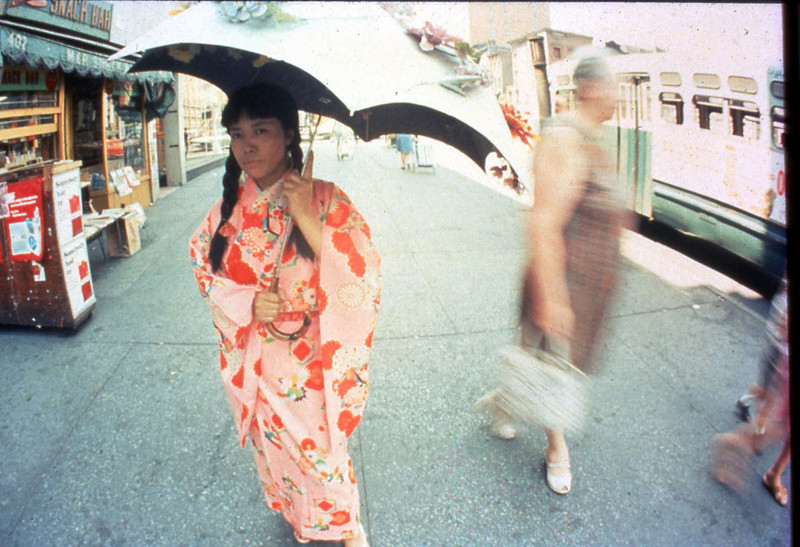Yayoi Kusama
24 Oct 2013 - 20 Feb 2014
YAYOI KUSAMA
Walking Piece, 1966
24 October 2013 – February 2014
Projection on the outer wall of the gallery building
The slide installation Walking Piece, 1966, by Yayoi Kusama, is the oldest work of media art in Sammlung Goetz. It depicts the Japanese artist as she strolls through New York, away from the city's main avenues. Clothed in a traditional kimono and carrying an umbrella decorated with plastic flowers, Kusama seems to be a very alien presence in this western metropolis
Yayoi Kusama was raised in a strict, traditional Japanese home. As a result of pressure from her family, she developed mental illness at a young age. It showed itself as hallucinations of dots and nets that she saw everywhere in her environment. The boundaries between subjects, objects and the environment seem to dissolve into each other. Due to her delusions, Kusama began psychiatric treatment but simultaneously expressed in her art this new experience of the dissolution of borders. The so-called "Polka Dots" that she painted on pictures, furniture, sculpture and walls thus became her trademark.
Kusuma soon began to gain her first successes. Her works were exhibited in the 18th Biennial in the Brooklyn Museum in 1955. To escape the pressure from her family as well as the conservative ideas of art in Japan, Kusama moved to New York in 1957. Although she soon established herself on the international art scene with her happenings and performances, she felt alienated in the huge city. The slide projection Walking Piece, which consists of 25 individual images created nine years after her move, focuses on feelings of homelessness and foreignness.
Yayoi Kusama (born in 1929 in Matsumoto, Nagano Prefecture, JP, lives and works in Tokyo, JP).
Walking Piece, 1966
24 October 2013 – February 2014
Projection on the outer wall of the gallery building
The slide installation Walking Piece, 1966, by Yayoi Kusama, is the oldest work of media art in Sammlung Goetz. It depicts the Japanese artist as she strolls through New York, away from the city's main avenues. Clothed in a traditional kimono and carrying an umbrella decorated with plastic flowers, Kusama seems to be a very alien presence in this western metropolis
Yayoi Kusama was raised in a strict, traditional Japanese home. As a result of pressure from her family, she developed mental illness at a young age. It showed itself as hallucinations of dots and nets that she saw everywhere in her environment. The boundaries between subjects, objects and the environment seem to dissolve into each other. Due to her delusions, Kusama began psychiatric treatment but simultaneously expressed in her art this new experience of the dissolution of borders. The so-called "Polka Dots" that she painted on pictures, furniture, sculpture and walls thus became her trademark.
Kusuma soon began to gain her first successes. Her works were exhibited in the 18th Biennial in the Brooklyn Museum in 1955. To escape the pressure from her family as well as the conservative ideas of art in Japan, Kusama moved to New York in 1957. Although she soon established herself on the international art scene with her happenings and performances, she felt alienated in the huge city. The slide projection Walking Piece, which consists of 25 individual images created nine years after her move, focuses on feelings of homelessness and foreignness.
Yayoi Kusama (born in 1929 in Matsumoto, Nagano Prefecture, JP, lives and works in Tokyo, JP).

